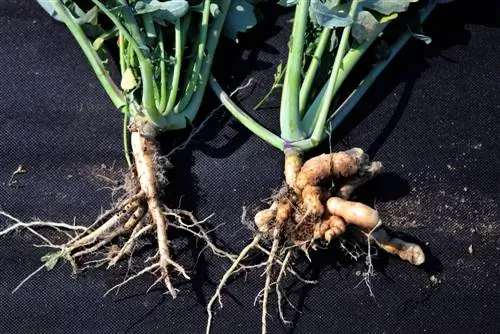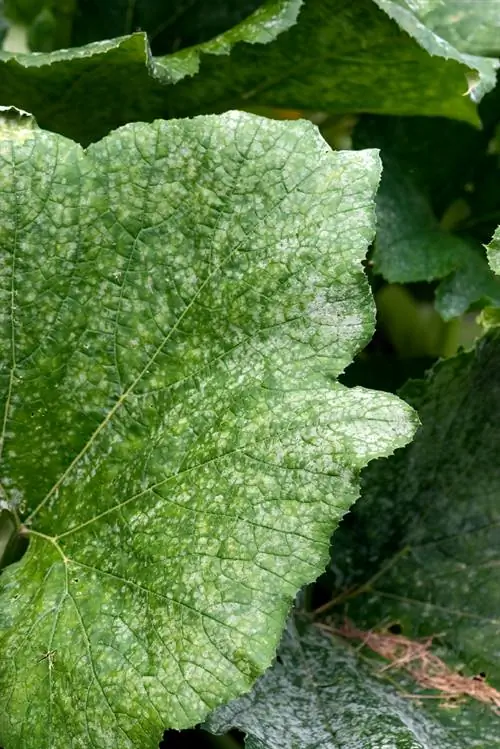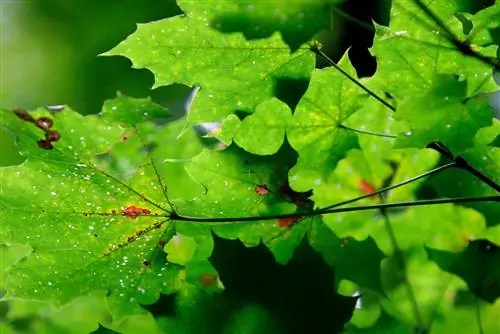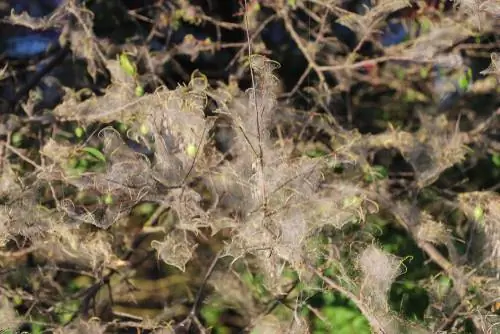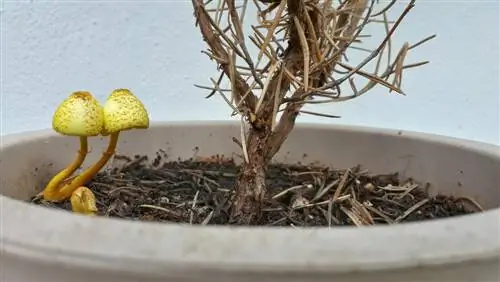- Author admin [email protected].
- Public 2023-12-16 16:46.
- Last modified 2025-06-01 06:02.
Cabbage root is a fungal disease that mainly affects cabbage, but also other cruciferous vegetables. The pathogen is difficult to combat because its spores persist in the soil. What really helps.
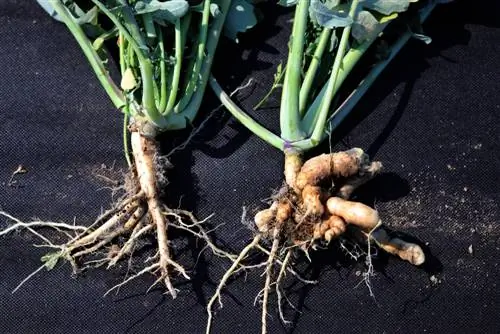
What is clubroot and how can you prevent it?
Cabbage root is a fungal disease that affects cabbage and cruciferous plants and is recognized by thickened roots and wilting plants. Preventative measures include optimal site and soil conditions, crop rotation and the use of resistant cabbage varieties. Direct combat is not possible.
- Clubroot is a fungal plant disease that primarily affects brassicas and other cruciferous plants.
- The bulbous, thickened roots are characteristic, and infected plants also wilt.
- The fungus lives in the soil, which is why it is essential to take a break of three to five years after growing cabbage.
- There are no direct ways to combat it, only preventative measures.
What is Clubroot?
Clubroot is a fungal disease that often occurs on cruciferous vegetables. The cause is a slime mold with the scientific name Plasmodiophora brassicae, which lives in the soil and forms permanent spores there. Once infected, these survive for up to 20 years. The fungus penetrates through the roots and primarily causes the underground parts of the plant to grow uncontrollably. The resulting bulbous thickenings in turn damage the pathways of the plants and ensure that the plant is no longer adequately supplied with water and nutrients. Infected plants often wilt and die.
Which plants are particularly often affected?
All types of cabbage are particularly often affected by clubroot, but especially kohlrabi and Brussels sprouts. Broccoli, cauliflower, red and white cabbage, savoy cabbage, kale and Chinese cabbage are also affected. But not only cabbage, other vegetables and ornamental plants are also at risk if they belong to the cruciferous family. These include, for example:
- Raps
- Mustard
- Rocket, garlic rocket
- cress
- Radish
- Gold lacquer
- Barbara herb
- Silverleaf
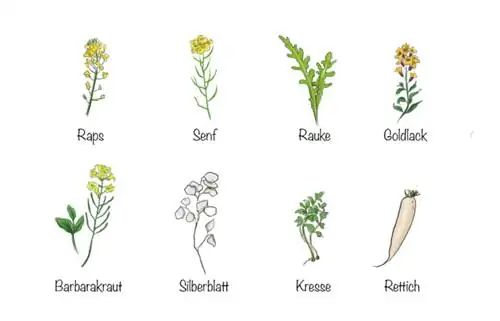
Tip
If “weeds” such as shepherd’s purse, meadowfoam or famine appear in the vegetable or ornamental bed, pull them out as quickly as possible. They also belong to the cruciferous family and can carry the infection into the bed - the shepherd's purse in particular is susceptible to clubroot.
Identifying club hernia - damage and symptoms
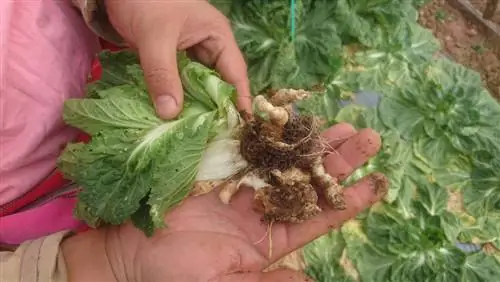
The best way to recognize clubroot is by its thickened roots
The clubroot pathogen feels particularly comfortable in moist and warm soil, especially if the pH value is also in the acidic range. In this environment, the slime mold finds the best living conditions and reproduces abundantly. Its extremely durable spores survive in the soil for up to 20 years - which is why the disease, once it has occurred, can break out again even after many years.
You can recognize an infection with Plasmodiophora brassicae by these features:
- poor growth of the affected cruciferous plants
- withering, yellowing leaves
- hanging leaves on warm days
- bully thickened roots
If you suspect clubroot, dig up one of the supposedly diseased plants and check its roots: These are typically thickened in a tuberous or cylindrical shape.
Excursus
Confusion with cabbage gall weevil and other pests
The clubroot doesn't always have to be behind the bulbous roots and wilting plant parts, sometimes it's just a pest like the larvae of the cabbage gall weevil. Inspect the diseased plant for the presence of larvae or adults and for feeding damage. Cut the thickened roots: if they are hollow inside, cabbage-eating larvae are probably at work.
Can clubroot be prevented?
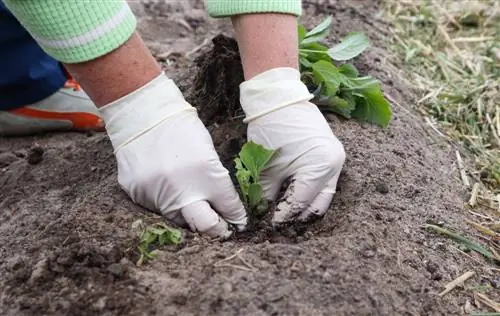
Cabbage must not be too moist and must be supplied with sufficient nutrients
“Once the clubroot is in the ground, the pathogen is very difficult to combat.”
Since clubroot, once it has broken out, is very difficult to treat, you must pay particular attention to effective prevention. This primarily includes two strategies:
- Optimize location and soil
- Observe crop rotation
On the first point, it should be said that clubroot spreads primarily on moist soils. So make sure there is good drainage so that the soil always dries well and is not constantly wet. When growing cabbage plants, prefer well-drained, sandy soils, but don't forget to fertilize them regularly - cabbage is a heavy feeder and needs a lot of nutrients.
Also check the pH value of the soil with a simple strip test and, if necessary, raise it by liming - if possible into the alkaline range. Liming not only helps prevent clubroot, but also provides the vegetable plants with an important nutrient. Garden lime has proven useful for this, but also primary rock powder.
When it comes to crop rotation, please note that no further cabbage or cruciferous plants may be cultivated on a bed where you have grown cabbage and other cruciferous plants for the next three to five years. If this is not possible, for example due to a lack of space, first apply green manure after the harvest (no rapeseed or mustard!) and then apply plenty of humus - for example in the form of ripe compost. Both help to keep the amount of fungal spores as low as possible. Plants infected with club root and crop residues should never be put in the compost heap, but should always be thrown into the residual waste.

Are there resistant varieties of cabbage?
The following cabbage varieties are currently listed as resistant to club root: 'Clapton F1' (cauliflower), 'Kilaton F1' and 'Kikaxy F1' (both white cabbage), 'Crispus' (Brussels sprouts) and 'Autumn Fun F1' and 'Orient Surprise F1' (both Chinese cabbage).
Fighting clubroot - These remedies help
It is not possible to combat clubroot directly. However, you should immediately pull infected plants out of the ground along with their roots and dispose of them with household waste.
Frequently asked questions
Can you still eat a cabbage affected by clubroot?
Yes, in principle this is possible - but only on the parts of the plant that have not yet been affected by the fungus. Cut off all affected parts generously and cook the remaining cabbage well.
Aren't there any chemical remedies that help against clubroot?
No, there are currently no plant protection products that are effective against clubroot and approved for home or hobby gardens. Sulfur, copper and broad-spectrum fungicides also have no effect.
Tip
If clubroot has already appeared on a bed, you should not plant strawberries there. Although they are not susceptible to the diseases themselves, they can keep the fungus alive and thus continue to multiply.

